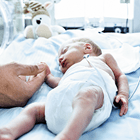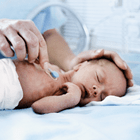Printed from acutecaretesting.org
September 2003
Transcutaneous monitoring - a Danish approach
Babies are left undisturbed
The NICU of the Copenhagen University Hospital has been using transcutaneous monitoring of oxygen and carbon dioxide as part of their patient monitoring since 1978. Transcutaneously monitored patients at the NICU include mechanically ventilated preterm babies (it is a hospital standard that all mechanically ventilated preterms must be transcutaneously monitored), as well as babies suffering from congenital heart disease.
Transcutaneous monitoring is also used during pre- and postoperative care and patient transport. Not only neonates but also young pediatric patients are monitored transcutaneously.
Other monitoring methods to supplement transcutaneous values include pulse oximetry, which is widely used, and arterial blood gas measurements. End tidal measurements are rarely used. Gorm Greisen explains: "We do have a few end tidal capnographs, which we use during patient transport.
However, we will soon start using end tidal to check proper tube placement after intubation. The problem is that in newborn babies with small tidal volumes, end tidal underestimates arterial pCO2 values by 30 to 70 %."
According to Gorm Greisen, it is important to correlate transcutaneous monitoring results with those obtained by other methods.
What if a sudden discrepancy in values occurs? Gorm Greisen explains: "We always evaluate the total picture. If tcpCO2 increases and other values appear normal, we check whether the transcutaneous electrode needs recalibration instead of rushing to take a blood sample.
Ideally, continuous monitoring should minimize the need for arterial blood sampling. Some hospitals have a routine of drawing blood every six hours or every morning. Not here, though. If the transcutaneous readings are stable, the babies are left undisturbed."
Shorter lengths of stay
According to Gorm Greisen, it is difficult to scientifically prove that transcutaneous monitoring leads to improved patient outcome. In his opinion, "studies can show how effective a monitoring method is, but it is hard to prove how a single method affects the clinical outcome."
When asked about the financial advantages of using transcutaneous monitoring, e.g. shorter length of stay, Gorm Greisen replies: "I have never thought of transcutaneous monitoring as a way to shorten length of stay, but rather as a way to diagnose a patient.
But I suppose that the better you can diagnose patients, the less likely complications are to arise, and that of course can lead to a shorter length of stay."
Pros and cons of transcutaneous monitoring
The monitoring method, like any other, has its advantages and disadvantages. But for Gorm Greisen, the benefits of continuous monitoring outweigh any drawback:The main advantage of transcutaneous monitoring is the ability to monitor oxygen and carbon dioxide continuously - and non-invasively.
"Many hospitals use only arterial blood gas samples and pulse oximetry to monitor oxygen and carbon dioxide," explains Gorm Greisen. "However, these two methods alone do not provide continuous monitoring of pCO2, and that can be a problem.
A lot can happen to a critically ill preterm baby in the course of 30 minutes. Carbon dioxide can rise - or fall - dramatically. When you don't have continuous monitoring of pCO2, the chances of detecting those changes and reacting to them in time become smaller."
Nurses conduct all transcutaneous monitoring in the hospital. Training in the method is part of their general training. Staff turnaround is very high: 25 % of all nurses have been at the unit for less than a year.
Therefore, keeping the staff properly trained is a big challenge. "Transcutaneous monitors are not the only instruments nurses use," says Gorm Greisen. "Therefore, operational simplicity is essential."
Even though using a transcutaneous monitor is not particularly difficult, there are a series of procedures that nurses need to be aware of to ensure correct readings. Procedures include how to fasten electrodes properly onto the fixation rings and where to place them on patients. "These may seem like small details, but you have to be aware of them in order to ensure correct results," says Gorm Greisen.
Gorm Greisen evaluates the benefits and drawbacks of transcutaneous monitoring as follows:
|
Pros |
Cons |
|
|
Get users involved
For those hospitals wishing to invest in transcutaneous technology, Gorm Greisen recommends getting the nursing staff involved as much as possible in the process.
"Sometimes doctors attend commercial conferences and get excited about a product," he explains. "But if nurses - the users - cannot see the value in them, these products end up not being used. The users must be involved in the process. They must see how this equipment will help them in their everyday care for the patients. Or else the technology will never be used."
|
The Department of Neonatology - Copenhagen University Hospital:
|
Interviewers
Ana Cristina Magalhães and Gitte JuelRadiometer Medical A/S
Åkandevej 21
DK-2700 Brønshøj
Denmark
Acute care testing handbook
Get the acute care testing handbook
Your practical guide to critical parameters in acute care testing.
Download nowRelated webinar
Combining blood gas invasive and non-invasive monitoring for the best care of our neonates
Webinar presented by Dr. Kaare E. Lundstrøm, Pediatric emergency and intensive care unit, Rigshospitalet, Denmark Watch the webinarRelated webinar
Transitioning from snapshot to continuous neonatal monitoring
Reducing Risk, Comorbidities, and Invasive Ventilation in the NICU. Presented by Marty Sandoval, RRT, NPS, RCP (California), Respiratory Manager, Children's Services Pomona Valley Hospital Medical Center Watch the webinarScientific webinars
Check out the list of webinars
Radiometer and acutecaretesting.org present free educational webinars on topics surrounding acute care testing presented by international experts.
Go to webinars










